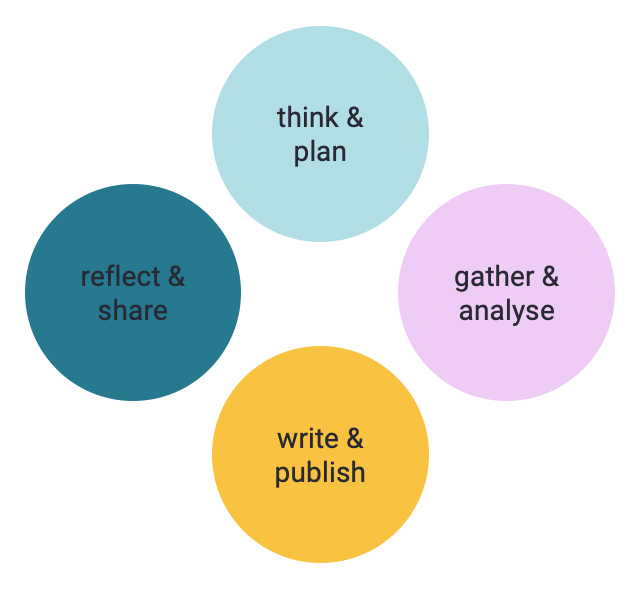
Formulating a good research question is crucial as it guides the direction and focus of your study. A well-defined question helps clarify the purpose of the research, ensures that the investigation is manageable, and facilitates the collection of relevant data. Ultimately, it lays the foundation for meaningful and impactful findings.
Before you get started, watch this short overview of research design:
Slides are available here: Research Design Slides

The research process is often depicted as a cycle with several steps that researchers move through as they work on their project. There is no prescribed way of doing research, but there are some key stages that will be similar in each project. Most projects begin with a broad question, theme, idea, or hypothesis. In the next steps, the researcher explores and refines their work into a clear and specific research question.
The topic is the general area of enquiry. When deciding on the general topic for you project, we recommend choosing an area of interest to you, as this will have a direct impact on your motivation.
Examples from an educational context might be:
Idea generation and/or concept mapping can help develop the topic into subtopics and then through to the question.
Idea generation is a tried and tested method for generating a wide range of ideas and solutions for a particular problem, and you’ve probably used it in your own classrooms at some point. The focus is on quantity and creativity without being overly concerned about organisation structure. Free thinking and generation of ideas are key.
Taking the first topic, Enhancing programming skills as an example, one might generate the following list of ideas:
The concept map is an associated technique that draws out the connections between concepts in a topic. Here key concepts are identified and systematically arranged to illustrate the relationships.
For example, with the topic Enhancing programming skills one might come up with:

For our purposes, the fact that a particular question has been researched and investigated before does not preclude you from testing the same question, building resources and evaluating them with your students. We may have heard from others about how the use of physical computing tools such as the BBC micro:bit has engaged students in a neighbouring school and you’d like to try it out for yourself.
However, spending time reviewing what has been researched previously can be illuminating and helps to narrow the focus of the research question.
Access to research literature can be difficult for teachers as many academic papers are behind a paywall but there are some avenues open to use that are worth exploring:
If, as part of your search, you encounter an academic paper you would like to read, do get in touch and we will check if we can arrange access.
Once you have gathered enough knowledge on the topic you want to pursue, you can start focusing on a more specific area of study and narrowing down a research question.
There are some useful approaches and additional questions here that can help you arrive at the final question to be researched:
Consider using a framework, such as the PICOT approach, to narrow down your question.
For example, you may be interested in the use of PRIMM and a first stab at your question might be:
Does using PRIMM help program comprehension?
Looking at the headings above, how might this be improved?
Does using PRIMM in Year 8 help program comprehension?
Does using a targeted Predict exercise at the beginning of Year 8 programming lessons help program comprehension?
Does using a targeted Predict exercise at the beginning of Year 8 programming lessons help program comprehension in comparison to a control group?
Does using a targeted Predict exercise at the beginning of Year 8 programming lessons help my students explain their programs orally in comparison to a control group?
Does using a targeted Predict exercise at the beginning of Year 8 programming lessons for 4 weeks help my students explain their programs orally in comparison to a control group?
Developing the right research question is a critical first step in the research process.
Activity:
Fill in the Research Planning form below. Think about the topic you would like to investigate and formulate a research question. Think about your investigation or intervention and make notes in the remaining boxes. You can come back to your research plan once you have finished the next module.